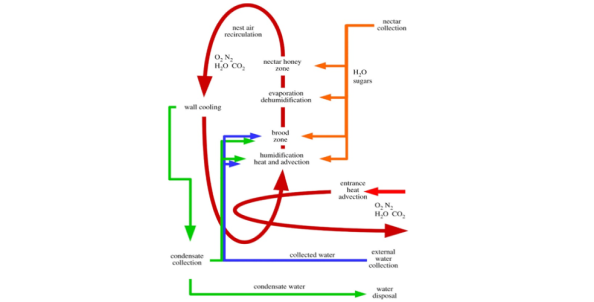Langstroth’s “Intelligent Cultivator” Part 6 of 7 – Humidity and Varroa Mortality
- Posted
Humidity Regulation and Varroa Destructor Mortality
The thermofluid physics in the production and removal of water vapor binds the behaviors of the honeybee colony. Honeybees must produce and dispose of considerable quantities of water vapor to convert nectar into honey. This is typically 4 to 7 times the weight of the honey and as warm water vapor rises benefiting the brood zone before cooling and condensing for collection and possible reuse for evaporative cooling of the same brood.
Tree nests with their tall and narrow cavities, thick walls coated with propolis with its low water vapor permeability, infinite thickness above, and bottom entrances can see the humidity in the air surrounding the nest rise to circa 90% when active brood rearing is present, and nectar is being processed. The thermal conductance of the nest and the dimensions of the entrance have a major impact on nest humidity. This makes high humidity a much more likely and frequent occurrence in tree nests and low humidity found in man-made nests a likely stressor. It is highly likely that honeybees, in temperate climates and in their natural home, with much smaller thermal conductance and entrance, can achieve higher humidity more easily and more frequently than in man-made hives.
In recent studies on the topic high tree nest humidity and CO2 levels have been shown to result in very poor varroa breeding success. In contrast, higher humidity has been shown to improve survival in Apis mellifera carnica and A. mellifera jemenitica. Higher warm humidity improves both honeybee egg viability and larvae development. The results from the studies demonstrated that at 25°C/77°F restricted ventilation resulted in high levels of CO2 in the surrounding environment of small clusters of honeybees. This had the effect of substantially increasing varroa mortality. Also, varroa fertility declined at relative humidity of 100% and temperatures of about 87F which likely can only be achieved based on the higher humidity possible in these low thermal conductance, small entrance tree nests.
As an aside, top vents have been shown to tie inside to outside humidity, which even in subtropical climates is substantially below the ideal for larval growth and the reduction of varroa fertility. Therefore, they may increase the levels of honeybee stress and the likelihood of varroa infestation. This would imply that hive thermal conductance and number and size of the entrances can potentially change the impact of varroa on honeybee colonies because of the resulting internal temperature, humidity, and CO2 levels.
